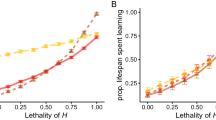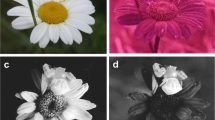Abstract
Classical mimicry theory distinguishes clearly between the mutualistic resemblance between two or more defended species (muellerian mimicry), and the parasitic resemblance of a palatable species to a defended species (batesian mimicry). Modelling the behaviour of predators, without initially taking ecological complications into account, is a good strategy for exploring whether this division is valid. Two such behavioural models are described: conditioning theory, which simulates changes in motivational attack levels according to the norms of current learning theory; and saturation theory, which considers how a predator may become saturated with a particular toxic compound, and then cease feeding on the prey species that delivers it. This effect is to be clearly distinguished from simple satiation. Most formulations of the conditioning model allow the direction of reinforcement produced by a particular prey to change according the predator's current state of motivation: this leads to the existence of quasi-batesian mimicry, a parasitic mimicry between two species that could both be described as defended. At high densities, two prey species that share a chemical defense will be ‘muellerian mutualists’, mutually protecting each other against predators that have been saturated with the defensive compound. This mutualism may be accompanied by true muellerian mimicry of the colour patterns, or the patterns may be completely different. This can therefore be regarded as a form of mimicry in a non-visual communication channel. Even an apparently palatable prey species may be effectively unavailable to predators if its density is such as to deliver a particular nutrient in excess of the predator's need for a balanced diet. Such a nutrient in effect becomes a toxin, and such an abundant prey species would be partly defended and potentially able to act as the model in a mimicry system. Thus there might be protective mimicry between ‘palatable’ species, and a ‘palatable’ species might even function as the model for a ‘defended’ mimic. These unorthodox kinds of mimicry probably exist transiently during fluctuations of prey populations. It is less likely that these conditions persist for long enough to induce the evolution of mimicry, and the relationships perhaps usually occur when mimicry already exists for other reasons. Mimicry rings may be mutually stabilised by a combination of toxic mutualism and the exchange of species between the rings. Colour polymorphism in a defended species is strictly neutral whenever the population is dense enough to saturate the predator. This, as well as quasi-batesian mimicry, may help to explain the minority of warningly coloured species that are polymorphic.
Similar content being viewed by others
References
Beccaloni, G. (1997) Vertical stratification of ithomiine butterfly (Nymphalidae: Ithomiinae) mimicry complexes: the relationship between adult flight height and larval host-plant height. Biol. J. Linn. Soc. 62, 313-341.
Benson, W.W. (1977) On the supposed spectrum between Batesian and Mullerian mimicry. Evolution 31, 454-455.
Brower, L.P. and Calvert, W.H. (1985) Foraging dynamics of bird predators of overwintering Monarch butterflies in Mexico. Evolution 39, 852-868.
Brower, L.P., Pough, F.H. and Meck, H.R. (1970) Theoretical investigations of auto-mimicry. I. Single trial learning. Proc. Nat. Acad. Sci. USA 66, 1059-1066.
Brown, K.S. and Benson, W.W. (1974) Adaptive polymorphism associated with multiple Mullerian mimicry in Heliconius numata (Lepid. Nymph.). Biotropica 6, 205-228.
Charlesworth, D. and Charlesworth, B. (1976) Theoretical genetics of Batesian mimicry. I. Singlelocus models. J. Theor. Biol. 55, 283-303.
Forbes, J.M. (1995) Voluntary Food Intake and Diet Selection in Farm Animals. CAB International, Wallingford.
Forbes, J.M. and Provenza, F.D. (2000) Integration of learning and metabolic signals into the theory of dietary choice and food intake. In P.B. Cronje (ed.) Ruminant Physiology, Digestion, Metabolism, Growth and Reproduction. CAB International, Wallingford, pp. 3-19.
Forbes, J.M. and Shariatmadari, F.F. (1994) Diet selection for protein by poultry. World's Poultry Sci. J. 50, 7-24.
Gilbert, L.E. (1983) Coevolution and mimicry. In D.J. Futuyma and M. Slatkin (eds) Coevolution. Sinauer, Sunderland, Massachusetts, pp. 263-281.
Huheey, J.E. (1964) Studies of warning coloration and mimicry. IV. A mathematical model of model-mimic frequencies. Ecology 45, 185-188.
Huheey, J.E. (1988) Mathematical models of mimicry. Am. Nat. 131, S22-S41.
Joron, M. and Mallet, J.L.B. (1998) Diversity in mimicry: paradox or paradigm? Trends Ecol. Evol. 13, 461-466.
Joron, M., Wynne, I.R., Lamas, G. and Mallet, J. (2001) Variable selection and the coexistence of multiple mimetic forms of the butterfly Heliconius numata. Evol. Ecol. 13, 721-754.
Mallet, J.L.B. and Joron, M. (2000) The evolution of diversity in warning colour and mimicry. Ann. Rev. Ecol. Syst. 30, 201-233.
Müller, F. [translated Meldola, R.] (1879) Ituna and Thyridia: a remarkable case of mimicry in butterflies. Trans. Ent. Soc. Lond. xx-xxix.
Murphy, M.E. (1994) Dietary complementation by wild birds — considerations for field studies. J. Biosci. 19, 355-368.
Owen, D.F., Smith, D.A.S., Gordon, I.J. and Owiny, A.M. (1994) Polymorphic Müllerian mimicry in a group of African butterflies: a re-assessment of the relationship between Danaus chrysippus, Acraea encedon and Acraea encedana (Lepidoptera: Nymphalidae). J. Zool. 232, 93-108.
Pearcy, S.D. and Murphy, M.E. (1997) Essential amino acid metabolism in moulting and non-moulting sparrows in different nutritional states. Comparative Biochemistry and Physiology — a Molecular and Integrative Physiology 118, 1157-1163.
Pough, F.H., Brower, L.P., Meck, H.R. and Kessell, S.R. (1973) Theoretical investigations of automimicry: multiple trial learning and the palatability spectrum. Proc. Nat. Acad. Sci. USA 70, 2261-2265.
Rothschild, M. (1971) Speculations about mimicry with Henry Ford. In E.R. Creed (ed.) Ecological Genetics and Evolution. Blackwell Scientific, Oxford, pp. 202-223.
Rothschild, M. (1981) The mimicrats must move with the times. Biol. J. Linn. Soc. 16, 21-23.
Sheppard, P.M. and Turner, J.R.G. (1977) The existence of Müllerian mimicry. Evolution 31, 452-453.
Sheppard, P.M., Turner, J.R.G., Brown, K.S. Jr., Benson, W.W. and Singer, M.C. (1985) Genetics and the evolution of muellerian mimicry in Heliconius butterflies. Phil. Trans. R. Soc. Lond. B 308, 433-607.
Smith, D.A.S., Owen, D.F., Gordon, I.J. and Owiny, A.M. (1993) Polymorphism and evolution in the butterfly Danaus chrysippus (L.) (Lepidoptera: Danainae). Heredity 71, 242-251.
van Someren, V.G.L. and Jackson, T.H.E. (1959) Some comments on protective resemblances amongst African Lepidoptera (Rhopalocera). J. Lepidopt. Soc. 13, 121-147.
Speed, M.P. (1990) Mimicry and the psychology of predation. Ph.D. Thesis, University of Leeds, UK.
Speed, M.P. (1993) Muellerian mimicry and the psychology of predation. Anim. Behav. 45, 571-580.
Speed, M.P. (2001) Batesian, quasi-Batesian or Mullerian mimicry? Theory and data in mimicry research. Evol. Ecol. 13, 755-776.
Speed, M.P., Alderson, N.J., Hardman, C. and Ruxton, G.D. (2000) Testing Müllerian mimicry: an experiment with wild birds. Proc. R. Soc. Lond. B 267, 1-7.
Speed, M.P. and Turner, J.R.G. (1999) Learning and memory in mimicry: II. Do we understand the mimicry spectrum? Biol. J. Linn. Soc. 67, 281-312.
Turner, J.R.G. (1984) Mimicry: the palatability spectrum and its consequences. In R.I. Vane-Wright and P.R. Ackery (eds) The Biology of Butterflies (Royal Entomological Society of London Symposium. No. 11). Academic Press, New York, pp. 141-161.
Turner, J.R.G. (1987) The evolutionary dynamics of batesian and muellerian mimicry: similarities and differences. Ecol. Ent. 12, 81-95.
Turner J.R.G. (1995) Mimicry as a model for coevolution. In R. Arai, M. Kato and Y. Doi (eds) Biodiversity and Evolution (Contributions to the International Biology Symposium of 1994). National Science Museum Foundation, Tokyo, pp. 131-150.
Turner, J.R.G. and Mallet, J.L.B. (1996) Did forest islands drive the diversity of warningly coloured butterflies? Biotic drift and the shifting balance. Phil. Trans. R. Soc. Lond. B 351, 835-845.
Turner, J.R.G. and Speed, M.P. (1996) Learning and memory in mimicry. I. Simulations of laboratory experiments. Phil. Trans. R. Soc. Lond. B 351, 1157-1170.
Turner, J.R.G., Kearney, E.P. and Exton, L.S. (1984) Mimicry and the Monte Carlo predator: the palatability spectrum and the origins of mimicry. Biol. J. Linn. Soc. 23, 247-268.
Whelan, C.J., Schmidt, K.A., Steele, B.B., Quinn, W.J. and Dilger, S. (1998) Are bird-consumed fruits complementary resources? Oikos 83, 195-205.
Author information
Authors and Affiliations
Corresponding author
Rights and permissions
About this article
Cite this article
Turner, J.R., Speed, M.P. How weird can mimicry get?. Evolutionary Ecology 13, 807–827 (1999). https://doi.org/10.1023/A:1010856716448
Issue Date:
DOI: https://doi.org/10.1023/A:1010856716448




